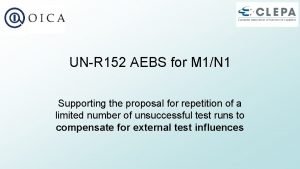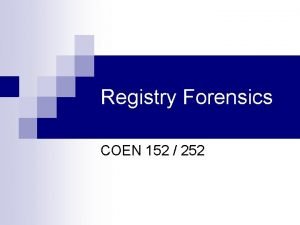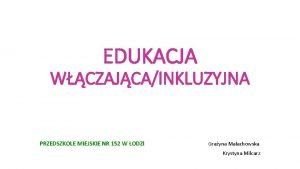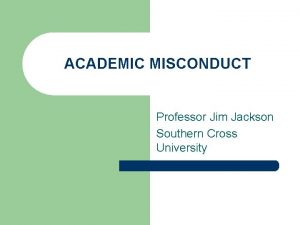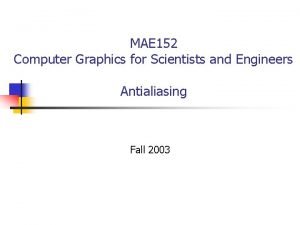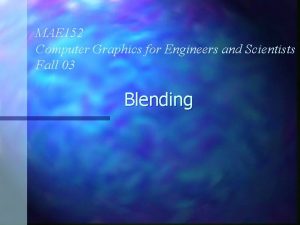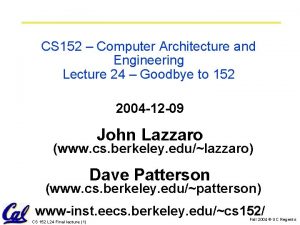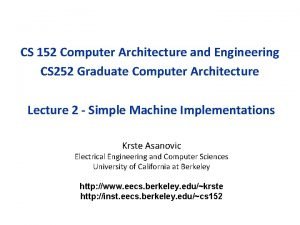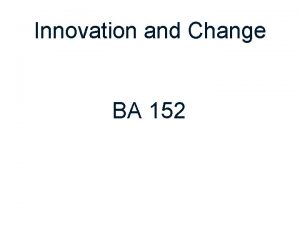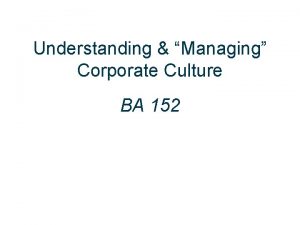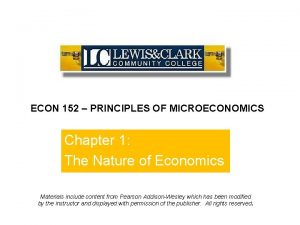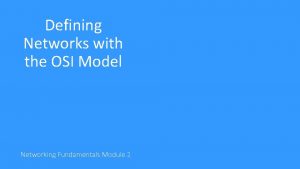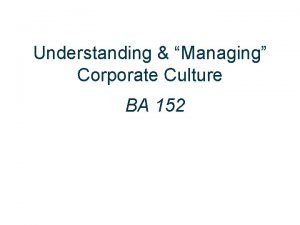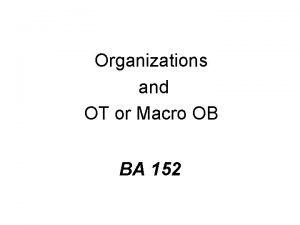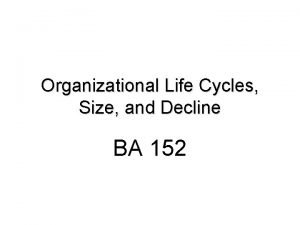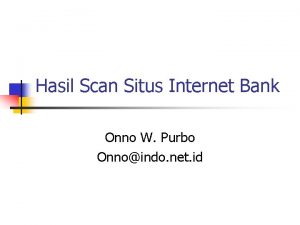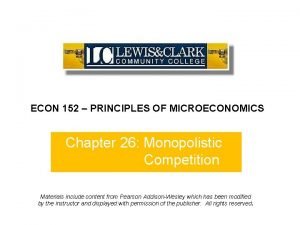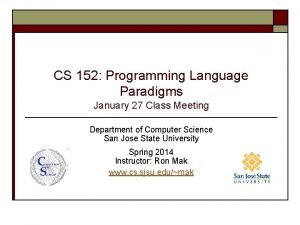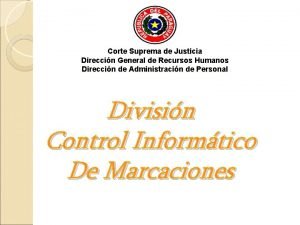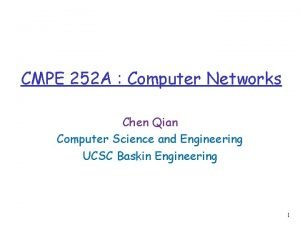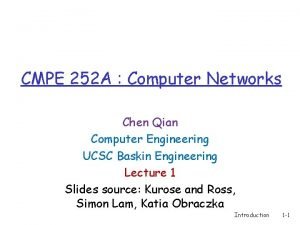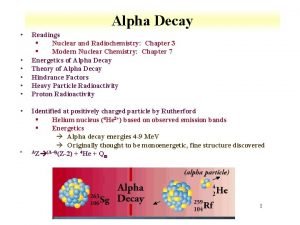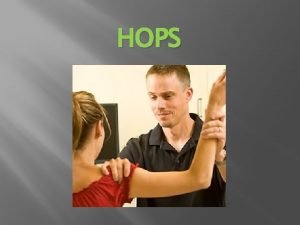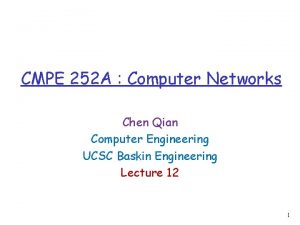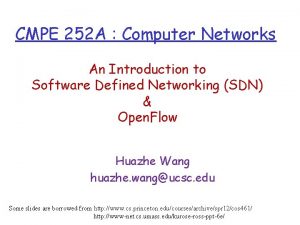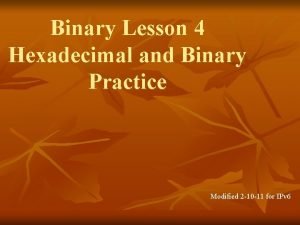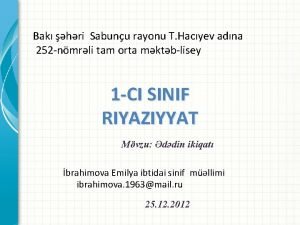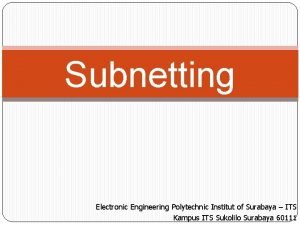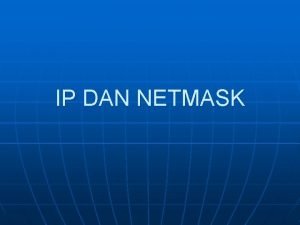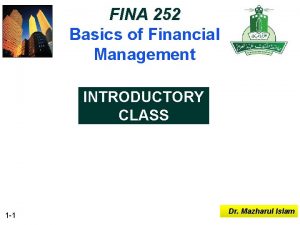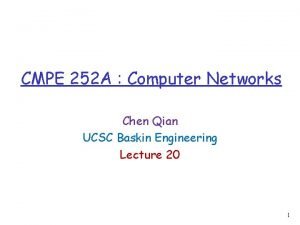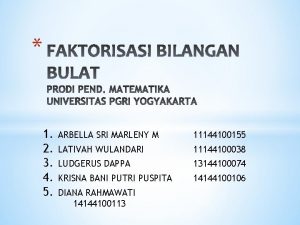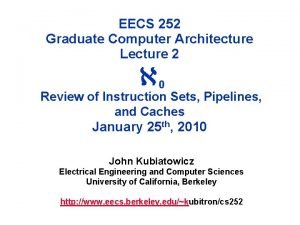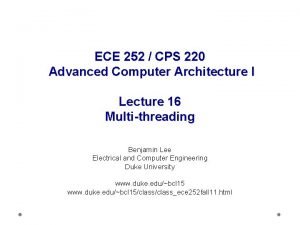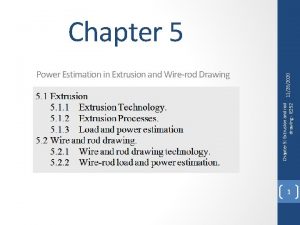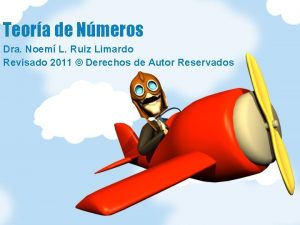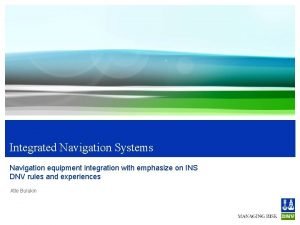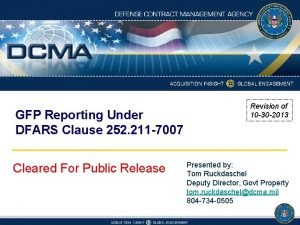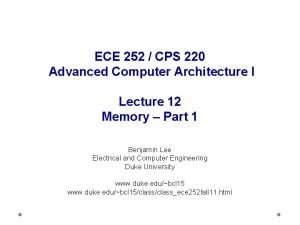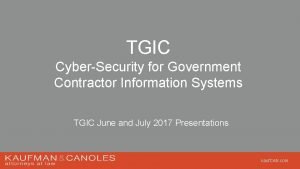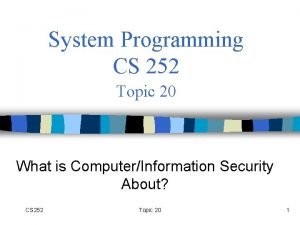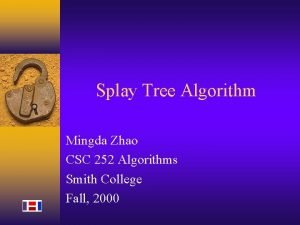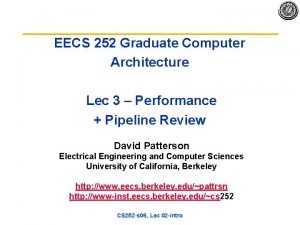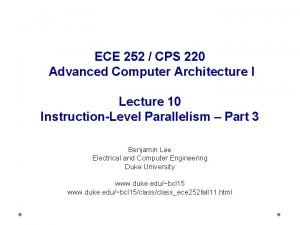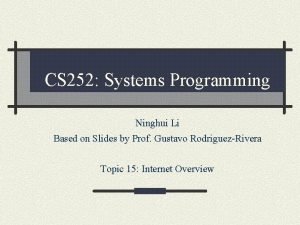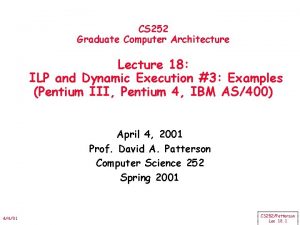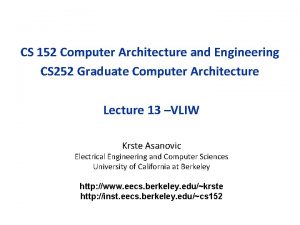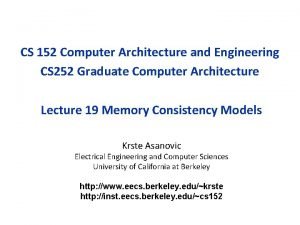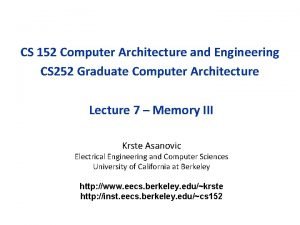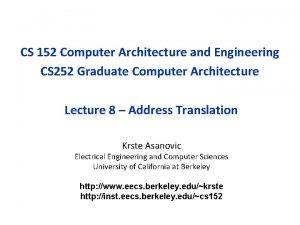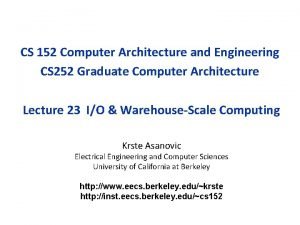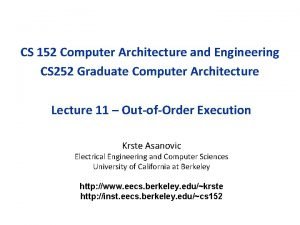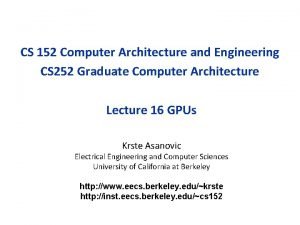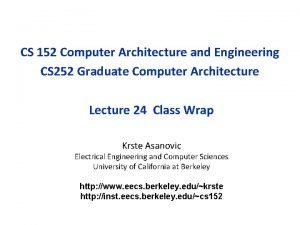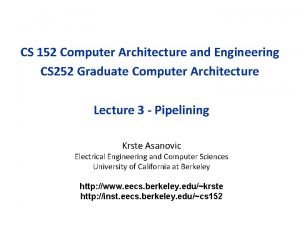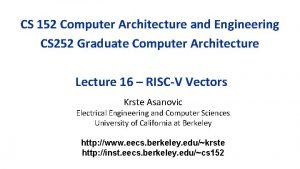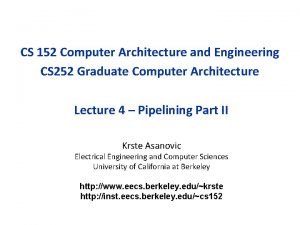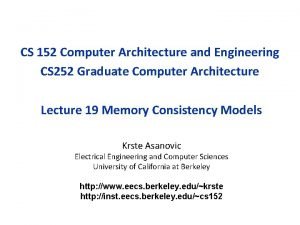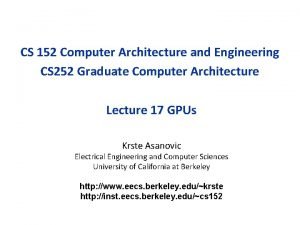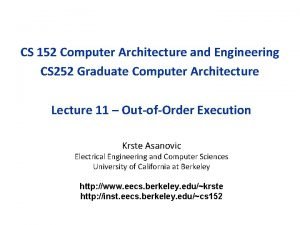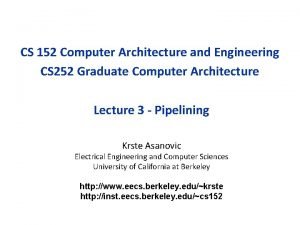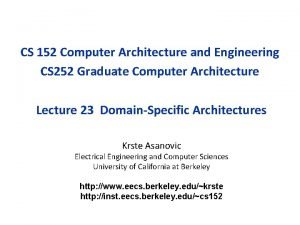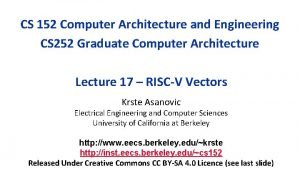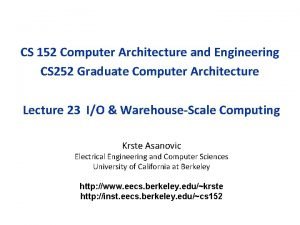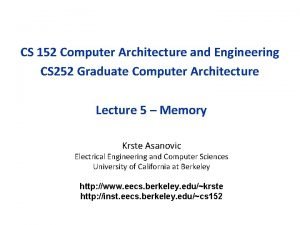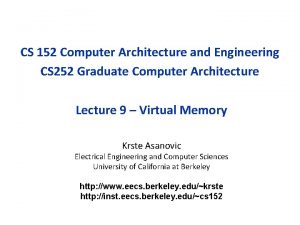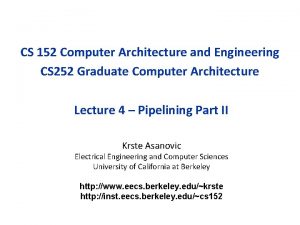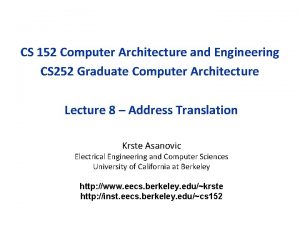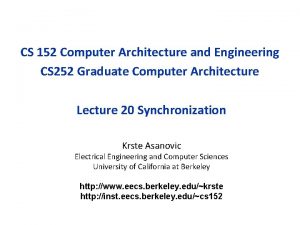CS 152 Computer Architecture and Engineering CS 252







![[ Hennessy & Patterson, 2017 ] Single-Thread Processor Performance 8 [ Hennessy & Patterson, 2017 ] Single-Thread Processor Performance 8](https://slidetodoc.com/presentation_image_h/9987ce8500837a4d20dd73c00f55c4e7/image-8.jpg)



























![ENIAC Changing the program could take days! [Public Domain, US Army Photo] 36 ENIAC Changing the program could take days! [Public Domain, US Army Photo] 36](https://slidetodoc.com/presentation_image_h/9987ce8500837a4d20dd73c00f55c4e7/image-36.jpg)





















- Slides: 57

CS 152 Computer Architecture and Engineering CS 252 Graduate Computer Architecture Lecture 1 - Introduction Krste Asanovic Electrical Engineering and Computer Sciences University of California at Berkeley http: //people. eecs. berkeley. edu/~krste http: //inst. eecs. berkeley. edu/~cs 152

What is Computer Architecture? Application Gap too large to bridge in one step (but there are exceptions, e. g. magnetic compass) Physics In its broadest definition, computer architecture is the design of the abstraction layers that allow us to implement information processing applications efficiently using available manufacturing technologies. 2

Abstraction Layers in Modern Systems Application Algorithm Programming Language Operating System/Virtual Machines Instruction Set Architecture (ISA) Microarchitecture Gates/Register-Transfer Level (RTL) Circuits Devices UCB EECS Courses CS 170 CS 164 CS 162 CS 152/252 EECS 151/251 EE 143 Physics 3

Computing Devices Then… EDSAC, University of Cambridge, UK, 1949 4

Computing Devices Now Sensor Nets Cameras Set-top boxes Media Players Laptops Games Servers Routers Smart phones Automobiles Robots Supercomputers 5

Architecture continually changing Applications suggest how to improve technology, provide revenue to fund development Applications Technology Com pat ibil ity Improved technologies make new applications possible Cost of software development makes compatibility a major force in market 6

? Major Technology Generations CMOS Bipolar n. MOS Vacuum Tubes p. MOS Relays Electromechanical [from Kurzweil] 7
![Hennessy Patterson 2017 SingleThread Processor Performance 8 [ Hennessy & Patterson, 2017 ] Single-Thread Processor Performance 8](https://slidetodoc.com/presentation_image_h/9987ce8500837a4d20dd73c00f55c4e7/image-8.jpg)
[ Hennessy & Patterson, 2017 ] Single-Thread Processor Performance 8

Upheaval in Computer Design • Most of last 50 years, Moore’s Law ruled – Technology scaling allowed continual performance/energy improvements without changing software model • Last decade, technology scaling slowed/stopped – – Dennard (voltage) scaling over (supply voltage ~fixed) Moore’s Law (cost/transistor) over? No competitive replacement for CMOS anytime soon Energy efficiency constrains everything • No “free lunch” for software developers, must consider: – Parallel systems – Heterogeneous systems 9

Today’s Dominant Target Systems • Mobile (smartphone/tablet) – >1 billion sold/year – Market dominated by ARM-ISA-compatible general-purpose processor in system-on-a-chip (So. C) – Plus sea of custom accelerators (radio, image, video, graphics, audio, motion, location, security, etc. ) • Warehouse-Scale Computers (WSCs) – – 100, 000’s cores per warehouse Market dominated by x 86 -compatible server chips Dedicated apps, plus cloud hosting of virtual machines Now seeing increasing use of GPUs, FPGAs, custom hardware to accelerate workloads • Embedded computing – Wired/wireless network infrastructure, printers – Consumer TV/Music/Games/Automotive/Camera/MP 3 – Internet of Things! 10

This Year: Combined CS 152/CS 252 • CS 152/CS 252 share lectures in 306 Soda, MW 10: 30 am-12: 00 pm – For CS 252 students, initial lectures are optional review material – some later lectures include some CS 252 -only material • CS 152/CS 252 share two midterms (in class, 80 minutes each) – but some questions marked as CS 152 only or CS 252 only • CS 152 has problem sets – CS 252 students welcome to use PS for revision, self-learning • CS 152 has labs – CS 252 students welcome to use labs for self-learning • CS 152 has discussion sections • CS 152 has final exam • CS 252 has paper readings with discussion in (Room/time TBD) • CS 252 has course projects with final presentation/paper 11

This year: Webcast • Playlist: https: //www. youtube. com/playlist? list=PLk. FD 6_4 0 KJIyln. E 5 g. Whg. O 8 Ms. DCga 6 LZLX • Live Stream: https: //www. youtube. com/c/esgeecs/live • Webcast is to provide additional resource for students • We will not be accommodating midterm/final exam conflicts due to taking overlapping class – Other documented conflicts will be supported 12

CS 152/CS 252 Administrivia Instructor: Prof. Krste Asanovic, krste@berkeley. edu Office: (inside ADEPT Lab) Office Hours: Wed. 8: 30 -9: 30 AM (email to confirm), 567 Soda T. A. s: Albert Ou, aou@eecs OH: TBD Yue Dai, yuedai 96@berkeley OH: TBD Lectures: MW, 10: 30 AM-12: 00 PM, 306 Soda 252 Readings discussion: TBD 152 Sections (begin Friday 1/31): Friday 12: 00 -2: 00 pm DIS 101 155 Kroeber Friday 2: 00 -4: 00 pm DIS 102 3109 Etcheverry Text: Computer Architecture: A Quantitative Approach, Hennessey and Patterson, 6 th Edition (2017) Readings assigned from this edition, some readings available in older editions – see web page. Web page: http: //inst. eecs. berkeley. edu/~cs 152 Lectures available online by 8 am before class Piazza: http: //piazza. com/berkeley/spring 2020/cs 152 13

CS 152 Course Grading • 15% Problem Sets – Intended to help you learn the material. Feel free to discuss with other students and instructors, but must turn in your own solutions. Grading based mostly on effort, but exams assume that you have worked through all problems. Solutions released after PSs handed in. • 25% Labs – Labs use advanced full architectural simulators – Directed plus open-ended sections to each lab • 60% Exams (two midterms plus final, 15%+30%) – Closed-book, no calculators, no smartphones, no smartwatch, no laptops, . . . – Based on lectures, readings, problem sets, and labs 14

CS 252 Course Grading • 20% Paper readings – Paper summaries, discussion participation • 30% Exams (two midterms, 15%+15%) – Closed-book, no calculators, no smartphones, no smartwatch, no laptops, . . . – Based on lectures, readings, problem sets, and labs • 50% Class Project – Substantial research project in pairs, regular 1 -1 meetings with staff, 10 -page conference-style paper and class presentation, 15

CS 152/CS 252 Crossovers • Berkeley undergrads cannot take CS 252 before CS 152 • CS 152 students can participate in 252 paper readings if room, but can not submit responses • CS 152 students can do a class project but won’t be graded • CS 152 students welcome to attend 252 final project presentations • CS 252 students can complete 152 PSs but won’t be graded • CS 252 students can take 152 labs but won’t be graded • CS 252 students can attend 152 discussion sections if room 16

CS 152 Labs • Each lab has directed plus open-ended assignments • Directed portion (2/7) is intended to ensure students learn main concepts behind lab – Each student must perform own lab and hand in their own lab report • Open-ended assignment (5/7) is to allow you to show your creativity – Roughly a one-day “mini-project” » E. g. , try an architectural idea and measure potential, negative results OK (if explainable!) – Students can work individually or in groups of two or three – Group open-ended lab reports must be handed in separately – Students can work in different groups for different assignments • Lab reports must be readable English summaries – not dumps of log files!!!!!! – We will reward good reports, and penalize undecipherable reports 17

Class ISA is RISC-V • RISC-V is a new free, simple, clean, extensible ISA we developed at Berkeley for education (61 C/151/152/252) and research (Par. Lab/ASPIRE/ADEPT) – RISC-I/II, first Berkeley RISC implementations – Berkeley research machines SOAR/SPUR considered RISC-III/IV • Both of the dominant ISAs (x 86 and ARM) are too complex to use for teaching or research • RISC-V has taken off commercially • RISC-V Foundation manages standard riscv. org • Now upstream support for many tools (gcc, Linux, Free. BSD, …) • Nvidia is using RISC-V in all future GPUs • Western Digital is using RISC-V in all future products • Samsung, Google, many others using RISC-V 18

Chisel simulators • Chisel is a new hardware description language we developed at Berkeley based on Scala – Constructing Hardware in a Scala Embedded Language • Labs will use RISC-V processor simulators derived from Chisel processor designs – Gives you much more detailed information than other simulators – Can map to FPGA or real chip layout • You need to learn some minimal Chisel in CS 152, but we’ll make Chisel RTL source available so you can see all the details of our processors • Can do lab projects based on modifying the Chisel RTL code if desired 19

Chisel Design Flow (also check out chipyard) Chisel Design Description Chisel Compiler FPGA Verilog ASIC Verilog FPGA Tools ASIC Tools FPGA Emulation GDS Layout 20

Questions? 21

Computer Architecture: A Little History Throughout the course we’ll use a historical narrative to help understand why certain ideas arose Why worry about old ideas? • Helps to illustrate the design process, and explains why certain decisions were taken • Because future technologies might be as constrained as older ones • Those who ignore history are doomed to repeat it – Every mistake made in mainframe design was also made in minicomputers, then microcomputers, where next? 22

Analog Computers § Analog computer represents problem variables as some physical quantity (e. g. , mechanical displacement, voltage on a capacitor) and uses scaled physical behavior to calculate results [Ben. Frantz. Dale, Creative Commons BY-SA 3. 0] [Marsyas, Creative Commons BY-SA 3. 0] Antikythera mechanism c. 100 BC Wingtip vortices off Cesna tail in wind tunnel

Digital Computers § Represent problem variables as numbers encoded using discrete steps - Discrete steps provide noise immunity § Enables accurate and deterministic calculations - Same inputs give same outputs exactly § Not constrained by physically realizable functions § Programmable digital computers are CSx 52 focus 24

Charles Babbage (1791 -1871) § Lucasian Professor of Mathematics, Cambridge University, 1828 -1839 § A true “polymath” with interests in many areas § Frustrated by errors in printed tables, wanted to build machines to evaluate and print accurate tables § Inspired by earlier work organizing human “computers” to methodically calculate tables by hand [Copyright expired and in public domain. Image obtained from Wikimedia Commons. ] 25

Difference Engine 1822 § Continuous functions can be approximated by polynomials, which can be computed from difference tables: f(n) = n 2 + n + 41 d 1(n) = f(n) – f(n-1) = 2 n d 2(n) = d 1(n) – d 1(n-1) = 2 § Can calculate using only a single adder: n 0 1 2 3 4 2 2 4 6 8 43 47 53 61 d 2(n) d 1(n) f(n) 41 26

Realizing the Difference Engine § Mechanical calculator, hand-cranked, using decimal digits § Babbage did not complete the DE, moving on to the Analytical Engine (but used ideas from AE in improved DE 2 plan) § Schuetz in Sweden completed working version in 1855, sold copy to British Government § Modern day recreation of DE 2, including printer, showed entire design possible using original technology - first at British Science Museum - copy at Computer History Museum in San Jose [Geni, Creative Commons BY-SA 3. 0 ] 27

Analytical Engine 1837 § Recognized as first general-purpose digital computer - Many iterations of the design (multiple Analytical Engines) § Contains the major components of modern computers: - “Store”: Main memory where numbers and intermediate results were held (1, 000 decimal words, 40 -digits each) - “Mill”: Arithmetic unit where processing was performed including addition, multiplication, and division - Also supported conditional branching and looping, and exceptions on overflow (machine jams and bell rings) - Had a form of microcode (the “Barrel”) § Program, input and output data on punched cards § Instruction cards hold opcode and address of operands in store - 3 -address format with two sources and one destination, all in store § Branches implemented by mechanically changing order cards were inserted into machine § Only small pieces were ever built 28

Analytical Engine Design Choices § Decimal, because storage on mechanical gears - Babbage considered binary and other bases, but no clear advantage over human-friendly decimal § 40 -digit precision (equivalent to >133 bits) - To reduce impact of scaling given lack of floating-point hardware § Used “locking” or mechanical amplification to overcome noise in transferring mechanical motion around machine - Similar to non-linear gain in digital electronic circuits § Had a fast “anticipating” carry - Mechanical version of pass-transistor carry propagate used in CMOS adders (and earlier in relay adders) 29

Ada Lovelace (1815 -1852) § Translated lectures of Luigi Menabrea who published notes of Babbage’s lectures in Italy § Lovelace considerably embellished notes and described Analytical Engine program to calculate Bernoulli numbers that would have worked if AE was built - The first program! § Imagined many uses of computers beyond calculations of tables § Was interested in modeling the brain [By Margaret Sarah Carpenter, Copyright expired and in public domain] 30

Early Programmable Calculators § Analog computing was popular in first half of 20 th century as digital computing was too expensive § But during late 30 s and 40 s, several programmable digital calculators were built (date when operational) - Atanasoff Linear Equation Solver (1939) Zuse Z 3 (1941) Harvard Mark I (1944) ENIAC (1946) 31

Atanasoff-Berry Linear Equation Solver (1939) § Fixed-function calculator for solving up to 29 simultaneous linear equations § Digital binary arithmetic (50 -bit fixed-point words) § Dynamic memory (rotating drum of capacitors) § Vacuum tube logic for processing In 1973, Atanasoff was credited as inventor of “automatic electronic digital computer” after patent dispute with Eckert and Mauchly (ENIAC) [Manop, Creative Commons BY-SA 3. 0 ] 32

Zuse Z 3 (1941) § Built by Konrad Zuse in wartime Germany using 2000 relays § Had normalized floating-point arithmetic with hardware handling of exceptional values (+/- infinity, undefined) - 1 -bit sign, 7 -bit exponent, 14 -bit significand § § 64 words of memory Two-stage pipeline 1) fetch&execute 2) writeback No conditional branch Programmed via paper tape Replica of the Zuse Z 3 in the Deutsches Museum, Munich [Venusianer, Creative Commons BY-SA 3. 0 ] 33

Harvard Mark I (1944) § Proposed by Howard Aiken at Harvard, and funded and built by § § § § § IBM Mostly mechanical with some electrically controlled relays and gears Weighed 5 tons and had 750, 000 components Stored 72 numbers each of 23 decimal digits Speed: adds 0. 3 s, multiplies 6 s, divide 15 s, trig >1 minute Instructions on paper tape (2 -address format) Could run long programs automatically Loops by gluing paper tape into loops No conditional branch Although mentioned Babbage in proposal, was more limited than analytical engine [Waldir, Creative Commons BY-SA 3. 0 ] 34

ENIAC (1946) § First electronic general-purpose computer § Construction started in secret at UPenn Moore School of § § § Electrical Engineering during WWII to calculate firing tables for US Army, designed by Eckert and Mauchly 17, 468 vacuum tubes Weighed 30 tons, occupied 1800 sq ft, power 150 k. W Twelve 10 -decimal-digit accumulators Had a conditional branch! Programmed by plugboard and switches, time consuming! Purely electronic instruction fetch and execution, so fast - 10 -digit x 10 -digit multiply in 2. 8 ms (2000 x faster than Mark-1) § As a result of speed, it was almost entirely I/O bound § As a result of large number of tubes, it was often broken (5 days was longest time between failures) 35
![ENIAC Changing the program could take days Public Domain US Army Photo 36 ENIAC Changing the program could take days! [Public Domain, US Army Photo] 36](https://slidetodoc.com/presentation_image_h/9987ce8500837a4d20dd73c00f55c4e7/image-36.jpg)
ENIAC Changing the program could take days! [Public Domain, US Army Photo] 36

EDVAC § ENIAC team started discussing stored-program concept to speed up programming and simplify machine design § John von Nuemann was consulting at UPenn and typed up ideas in “First Draft of a report on EDVAC” § Herman Goldstine circulated the draft June 1945 to many institutions, igniting interest in the stored-program idea - But also, ruined chances of patenting it - Report falsely gave sole credit to von Neumann for the ideas - Maurice Wilkes was excited by report and decided to come to US workshop on building computers § Later, in 1948, modifications to ENIAC allowed it to run in stored-program mode, but 6 x slower than hardwired - Due to I/O limitations, this speed drop was not practically significant and improvement in productivity made it worthwhile § EDVAC eventually built and (mostly) working in 1951 - Delayed by patent disputes with university 37

Manchester SSEM “Baby” (1948) § Manchester University group build small-scale experimental § § machine to demonstrate idea of using cathode-ray tubes (CRTs) for computer memory instead of mercury delay lines Williams-Kilburn Tubes were first random access electronic storage devices 32 words of 32 -bits, accumulator, and program counter Machine ran world’s first stored-program in June 1948 Led to later Manchester Mark-1 full-scale machine - Mark-1 introduced index registers - Mark-1 commercialized by Ferranti Williams-Kilburn Tube Store [Piero 71, Creative Commons BY-SA 3. 0 ] 38

Cambridge EDSAC (1949) § Maurice Wilkes came back from workshop in US and set about § § building a stored-program computer in Cambridge EDSAC used mercury-delay line storage to hold up to 1024 words (512 initially) of 17 bits (+1 bit of padding in delay line) Two’s-complement binary arithmetic Accumulator ISA with self-modifying code for indexing David Wheeler, who earned the world’s first computer science Ph. D, invented the subroutine (“Wheeler jump”) for this machine - Users built a large library of useful subroutines § UK’s first commercial computer, LEO-I (Lyons Electronic Office), was based on EDSAC, ran business software in 1951 - Software for LEO was still running in the 1980 s in emulation on ICL mainframes! § EDSAC-II (1958) was first machine with microprogrammed control unit 39

Commercial computers: BINAC (1949) and UNIVAC (1951) § Eckert and Mauchly left U. Penn after patent rights disputes and formed the Eckert-Mauchly Computer Corporation § World’s first commercial computer was BINAC with two CPUs that checked each other - BINAC apparently never worked after shipment to first (only) customer § Second commercial computer was UNIVAC - Used mercury delay-line memory, 1000 words of 12 alpha characters - Famously used to predict presidential election in 1952 - Eventually 46 units sold at >$1 M each - Often, mistakingly called the IBM UNIVAC 40

IBM 701 (1952) § IBM’s first commercial scientific computer § Main memory was 72 William’s Tubes, each 1 Kib, for total of 2048 words of 36 bits each - Memory cycle time of 12µs § Accumulator ISA with multipler/quotient register § 18 -bit/36 -bit numbers in sign-magnitude fixed-point § Misquote from Thomas Watson Sr/Jr: “I think there is a world market for maybe five computers” § Actually TWJr said at shareholder meeting: “as a result of our trip [selling the 701], on which we expected to get orders for five machines, we came home with orders for 18. ” 41

IBM 650 (1953) § The first mass-produced computer § Low-end system with drum-based storage and digit serial ALU § Almost 2, 000 produced [Cushing Memorial Library and Archives, Texas A&M, Creative Commons Attribution 2. 0 Generic ] 42

IBM 650 Architecture Magnetic Drum (1, 000 or 2, 000 10 -digit decimal words) 20 -digit accumulator Active instruction (including next program counter) Digit-serial ALU [From 650 Manual, © IBM] 43

IBM 650 Instruction Set § Address and data in 10 -digit decimal words § Instructions encode: - Two-digit opcode encoded 44 instructions in base instruction set, expandable to 97 instructions with options - Four-digit data address - Four-digit next instruction address - Programmer’s arrange code to minimize drum latency! § Special instructions added to compare value to all words on track 44

Early Instruction Sets § Very simple ISAs, mostly single-address accumulator- style machines, as high-speed circuitry was expensive - Based on earlier “calculator” model § Over time, appreciation of software needs shaped ISA § Index registers (Kilburn, Mark-1) added to avoid need for self-modifying code to step through array § Over time, more index registers were added § And more operations on the index registers § Eventually, just provide general-purpose registers (GPRs) and orthogonal instruction sets § But some other options explored… 45

Burrough’s B 5000 Stack Architecture: Robert Barton, 1960 § Hide instruction set completely from programmer using high-level language (ALGOL) § Use stack architecture to simplify compilation, expression evaluation, recursive subroutine calls, interrupt handling, … 46

Evaluation of Expressions (a + b * c) / (a + d * c - e) / + a - b e + * c a * d c Reverse Polish a b c * + a d c * + e - / push a push b push c multiply * c b a Evaluation Stack 47

Evaluation of Expressions (a + b * c) / (a + d * c - e) / + a - b e + * c a * d c Reverse Polish a b c * + a d c * + e - / add + b * c a a + b * c Evaluation Stack 48

IBM’s Big Bet: 360 Architecture § By early 1960 s, IBM had several incompatible families of computer: 701 → 7094 650 → 7074 702 → 7080 1401 → 7010 § Each system had its own - Instruction set - I/O system and secondary storage (magnetic tapes, drums and disks) - assemblers, compilers, libraries, . . . - market niche (business, scientific, real time, . . . ) 49

IBM 360 : Design Premises Amdahl, Blaauw and Brooks, 1964 § The design must lend itself to growth and successor machines § General method for connecting I/O devices § Total performance - answers per month rather than bits per microsecond → programming aids § Machine must be capable of supervising itself without manual intervention § Built-in hardware fault checking and locating aids to reduce down time § Simple to assemble systems with redundant I/O devices, memories etc. for fault tolerance § Some problems required floating-point larger than 36 bits 50

Stack versus GPR Organization Amdahl, Blaauw and Brooks, 1964 1. The performance advantage of push-down stack organization is derived from the presence of fast registers and not the way they are used. 2. “Surfacing” of data in stack which are “profitable” is approximately 50% because of constants and common subexpressions. 3. Advantage of instruction density because of implicit addresses is equaled if short addresses to specify registers are allowed. 4. Management of finite-depth stack causes complexity. 5. Recursive subroutine advantage can be realized only with the help of an independent stack for addressing. 6. Fitting variable-length fields into fixed-width word is awkward. 51

IBM 360: A General-Purpose Register (GPR) Machine § Processor State - 16 General-Purpose 32 -bit Registers - may be used as index and base register - Register 0 has some special properties - 4 Floating Point 64 -bit Registers - A Program Status Word (PSW) - PC, Condition codes, Control flags § A 32 -bit machine with 24 -bit addresses - But no instruction contains a 24 -bit address! § Data Formats - 8 -bit bytes, 16 -bit half-words, 32 -bit words, 64 -bit doublewords The IBM 360 is why bytes are 8 -bits long today! 52

IBM 360: Initial Implementations Storage Datapath Circuit Delay Local Store Control Store Model 30. . . Model 70 8 K - 64 KB 256 K - 512 KB 8 -bit 64 -bit 30 nsec/level 5 nsec/level Main Store Transistor Registers Read only 1�sec Conventional circuits IBM 360 instruction set architecture (ISA) completely hid the underlying technological differences between various models. Milestone: The first true ISA designed as portable hardwaresoftware interface! With minor modifications it still survives today! 53

IBM Mainframes survive until today [z 14, 2017, 14 nm technology, 17 layers of metal, 696 sq mm] 54

Server Market 55

And in conclusion … • Computer Architecture >> ISAs and RTL • CSx 52 is about interaction of hardware and software, and design of appropriate abstraction layers • Computer architecture is shaped by technology and applications – History provides lessons for the future • Computer Science at the crossroads from sequential to parallel computing – Salvation requires innovation in many fields, including computer architecture • Read Chapter 1 & Appendix A for next time! (5 th edition) 56

Acknowledgements • These slides contain material developed and copyright by: – – – Arvind (MIT) Krste Asanovic (MIT/UCB) Joel Emer (Intel/MIT) James Hoe (CMU) John Kubiatowicz (UCB) David Patterson (UCB) • MIT material derived from course 6. 823 • UCB material derived from course CS 252 57
 Computer architecture and computer organization difference
Computer architecture and computer organization difference Bus design in computer architecture
Bus design in computer architecture Computer based system engineering in software engineering
Computer based system engineering in software engineering Flowchart for memory reference instructions
Flowchart for memory reference instructions Unr 152
Unr 152 Ntuser.dat file
Ntuser.dat file Przedszkole 152 łódź
Przedszkole 152 łódź Re liveri 2006 qca 152
Re liveri 2006 qca 152 Round off 625 to the nearest hundred
Round off 625 to the nearest hundred Mae 152
Mae 152 Mae 152
Mae 152 Cs 152 stanford
Cs 152 stanford Cs 152 berkeley
Cs 152 berkeley Ba 152
Ba 152 Ece 152
Ece 152 Ba 152
Ba 152 Econ 152
Econ 152 Which layer of the osi model includes vlans
Which layer of the osi model includes vlans Ba 152
Ba 152 Macroob
Macroob Ba 152
Ba 152 Plasa
Plasa Econ 152
Econ 152 Sjsu cs 152
Sjsu cs 152 Gfi 152
Gfi 152 Acordada 961/15
Acordada 961/15 Chen qian ucsc
Chen qian ucsc Cmpe 252
Cmpe 252 Cf-252 decay scheme
Cf-252 decay scheme Simplify square root of 108
Simplify square root of 108 History observation palpation special tests
History observation palpation special tests Cmpe 252
Cmpe 252 Cmpe 252
Cmpe 252 4 en hexadecimal
4 en hexadecimal 252 nomreli mekteb
252 nomreli mekteb 252 netmask
252 netmask 252 netmask
252 netmask 252 basics
252 basics Qian chen ucsc
Qian chen ucsc Fpb dari 198
Fpb dari 198 252
252 Cps 220
Cps 220 Rod drawing
Rod drawing Descomposición prima de 2700
Descomposición prima de 2700 Msc.252(83)
Msc.252(83) Dfars 252
Dfars 252 Ece 252
Ece 252 Dfars 252 204 7012
Dfars 252 204 7012 Cs 252
Cs 252 Mingda zhao
Mingda zhao Chapter 252 florida statutes
Chapter 252 florida statutes 252 lec
252 lec Ece 252
Ece 252 Purdue cs 252
Purdue cs 252 Cs 252
Cs 252 Cs 252
Cs 252 Cs 252
Cs 252 Cs 252
Cs 252




